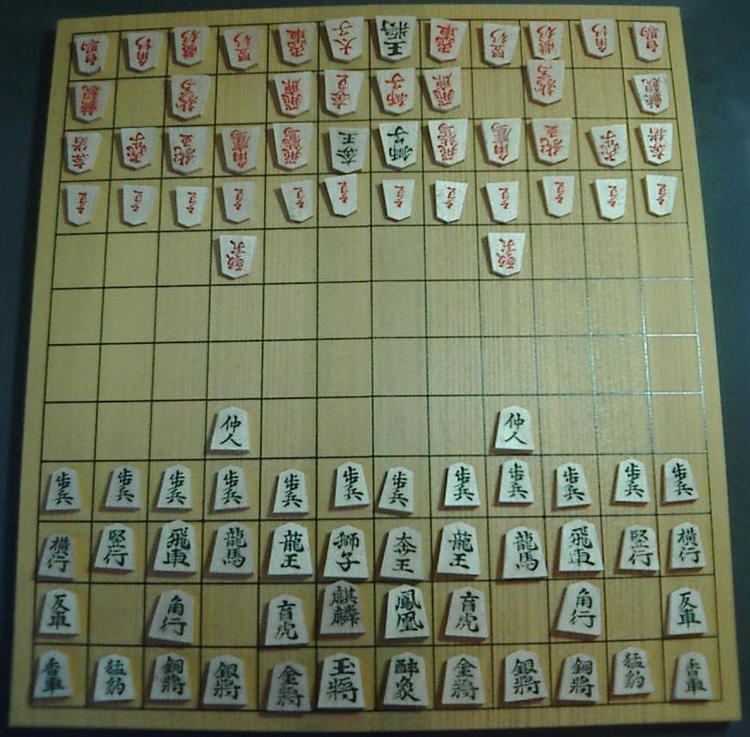 | ||
Hasami shogi (はさみ将棋 hasami shōgi, "sandwiching chess") is a variant of shogi (Japanese chess). Unlike other shogi variants, it has only one type of piece and is won by capturing all but one of the opponent's pieces.
Contents
Equipment
Two players, Black and White (or 先手 sente and 後手 gote), play on a shogi board, or one-quarter of a Go board – a grid of 9 ranks (rows) by 9 files (columns). The squares are undifferentiated by marking or color. Each player has a set of 9 wedge-shaped pieces or pawns (foot soldiers). Each pawn has its name in the form of two Japanese characters marked on its face (歩兵). On the reverse side of each pawn is the abbreviated character for tokin (と), often in a different color (e.g., red instead of black). Black plays with pawns and White plays with tokins.
Setup
To start the game, each side places their pieces on the nearest rank, one piece per cell.
Rules
Players alternate moves, with Black moving first. (The traditional terms Black and White are used to differentiate the sides in discussion; however, when shogi unpromoted pawns are used the pieces are undifferentiated except by their wedge directions.) A move consists of moving a piece to an empty cell of the board.
To win the game, a player must capture all but one of the opponent’s pieces.
Moving
All pieces move as a rook in shogi. (That is, any number of empty cells along a straight line in any orthogonal direction.) If a friendly or enemy piece intervenes, the moving piece cannot jump and can move only as far as the adjacent cell. If a friendly or enemy piece is adjacent, the moving piece is blocked from moving in that direction.
Capturing
An opponent piece is captured when the player occupies adjacent cells of the piece, either horizontally (on a rank) or vertically (on a file). (This "sandwiching" method of capture is called custodian capture.) Captured pieces are removed from the game. Multiple pieces are captured in a single move if all the cells between the capturing player's two pieces are occupied by opponent pieces.
If a player moves a piece to a cell between two enemy pieces, it is not captured, even though the moved piece is "sandwiched". Likewise, if a player moves a piece which fills a remaining unoccupied cell between two opponent pieces, the sandwiched pieces are not captured.
Dai hasami shogi
Dai hasami shogi is a variant of hasami shogi. It is the same as hasami shogi except that each player starts the game with 18 pieces occupying the two nearest ranks. Because most shogi sets only have 18 pawns total, this game is usually played with black and white go stones. The object is to capture either 10 or 17 stones.
A similar game is Mak-yek played in Siam (and Malaysia under the name Apit-sodok) with the same goal, on an 8x8 board, but the 16 stones of each player are placed on the first and third row. The moves are the same, but the capture is custodian and also by intervention. Intervention capture is the opposite of custodian. If a stone moves between two enemy stones, it captures both stones.
Dai Hasami Shogi is sometimes played with the additional winning condition of building a string of five stones, all of which must lie outside of the starting two rows for that player. This variant also allows for custodial captures of multiple pieces in a line, by "sandwiching" a continuous line of opposing pieces with two of one's own.
There is a hexagonal variant for Hasami Shogi, called Take invented in 1984 by Mike Woods. Curiously, there is an old Roman game, called Latrunculi seemly very similar to Hasami Shogi, but the exact rules are not known.
